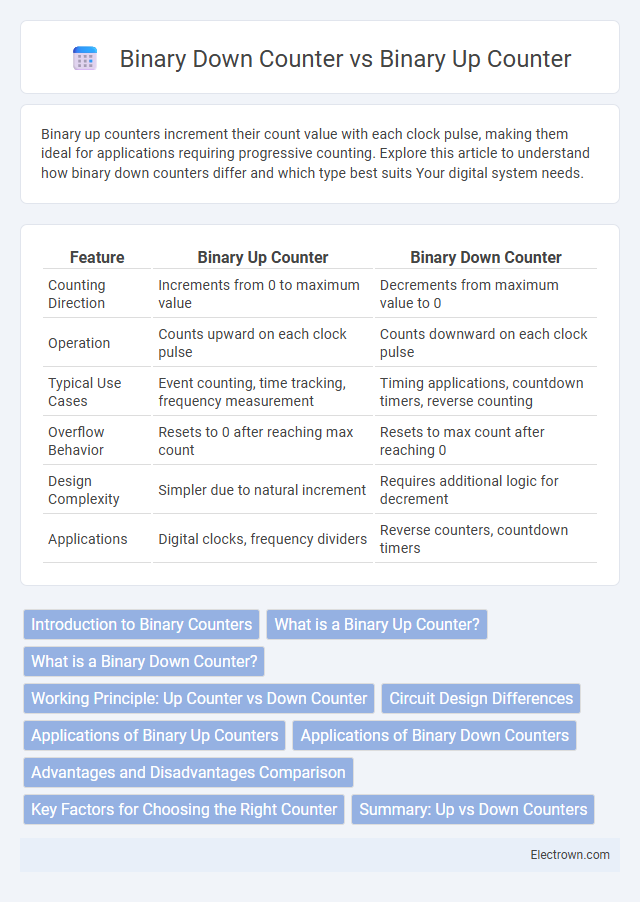Binary up counters increment their count value with each clock pulse, making them ideal for applications requiring progressive counting. Explore this article to understand how binary down counters differ and which type best suits Your digital system needs.
Table of Comparison
| Feature | Binary Up Counter | Binary Down Counter |
|---|---|---|
| Counting Direction | Increments from 0 to maximum value | Decrements from maximum value to 0 |
| Operation | Counts upward on each clock pulse | Counts downward on each clock pulse |
| Typical Use Cases | Event counting, time tracking, frequency measurement | Timing applications, countdown timers, reverse counting |
| Overflow Behavior | Resets to 0 after reaching max count | Resets to max count after reaching 0 |
| Design Complexity | Simpler due to natural increment | Requires additional logic for decrement |
| Applications | Digital clocks, frequency dividers | Reverse counters, countdown timers |
Introduction to Binary Counters
Binary counters are digital devices that sequentially count binary numbers, either increasing or decreasing their value in response to clock pulses. A Binary Up Counter increments its count with each clock pulse, making it ideal for applications requiring ascending order sequence tracking. Conversely, a Binary Down Counter decrements the count, useful for countdown timers and reverse sequencing, allowing you to manage both upward and downward binary sequences in digital circuits effectively.
What is a Binary Up Counter?
A Binary Up Counter is a digital circuit that sequentially counts in ascending binary order, increasing its value by one with each clock pulse. It is commonly used in applications such as digital clocks, frequency counters, and event counters where tracking increments is essential. Your choice between a Binary Up Counter and a Binary Down Counter depends on whether you need to count upward or downward for your specific circuit design.
What is a Binary Down Counter?
A Binary Down Counter is a digital device that decrements its binary value by one with each clock pulse, starting from a preset maximum count down to zero. It is commonly used in timing circuits, event counters, and digital clocks where reverse counting is required. Unlike a Binary Up Counter, which increments its value, the Binary Down Counter helps monitor remaining time or quantity by counting backward in binary form.
Working Principle: Up Counter vs Down Counter
Binary up counters increment their output by one with each clock pulse, counting from 0 to a maximum value before rolling over to 0. Binary down counters decrement their output by one with each clock pulse, counting backward from a preset maximum value down to 0. Your choice between an up counter and a down counter depends on whether you need to track increments or decrements in digital circuits.
Circuit Design Differences
Binary up counters increment the output count with each clock pulse, utilizing flip-flops configured to toggle from 0 to 1, propagating carry signals in ascending order. In contrast, binary down counters decrement the output, requiring flip-flops designed to toggle from 1 to 0, with borrow signals controlling the descending count sequence. The primary circuit design difference lies in the feedback paths and logic gates that manage carry and borrow operations, where up counters use ripple carry logic moving forward, while down counters implement borrow logic that effectively reverses the counting direction.
Applications of Binary Up Counters
Binary up counters are widely used in digital clocks, frequency dividers, and event counters due to their ability to sequentially count upward in binary form. Your digital systems benefit from their application in memory address generation and simple timer circuits, where increments are essential. These counters provide efficient timing control, enabling precise measurement and synchronization in embedded systems and microcontrollers.
Applications of Binary Down Counters
Binary down counters are widely used in digital systems for time delay generation, event counting, and frequency division. They play a crucial role in countdown timers, digital clocks, and pulse generation circuits where a specific number of clock pulses need to be tracked in reverse order. Industrial automation systems and microcontroller-based projects frequently utilize binary down counters to manage sequence control and resource allocation efficiently.
Advantages and Disadvantages Comparison
A Binary Up Counter offers simplicity in counting sequences from 0 to a maximum value, making it ideal for applications requiring ascending order timing or event tracking, but it may lack flexibility in applications needing countdown capabilities. In contrast, a Binary Down Counter excels in descending sequence operations, useful for time-delay circuits and resource allocation tasks, though it can be more complex to design and integrate with systems primarily based on incremental logic. Choosing between these counters depends on the specific application requirements, balancing ease of implementation against the need for counting direction versatility.
Key Factors for Choosing the Right Counter
When selecting between a Binary Up Counter and a Binary Down Counter, key factors include the direction of counting needed in your application, whether incrementing or decrementing values, and the specific timing requirements such as clock pulse frequency and synchronization. Consider your circuit's logic design constraints, as up counters are typically used in simple increment operations while down counters are preferred for countdown timers and reverse sequencing. Your choice should optimize performance and match the intended function to avoid unnecessary complexity and power consumption.
Summary: Up vs Down Counters
Binary up counters increment the binary value sequentially with each clock pulse, making them ideal for applications requiring counting or timing in ascending order. In contrast, binary down counters decrement the binary value with each clock pulse, useful for countdown timers or reverse sequencing tasks. Both counters are fundamental in digital electronics for tracking events, but their directionality determines their suitability for specific counting operations.
Binary Up Counter vs Binary Down Counter Infographic

 electrown.com
electrown.com